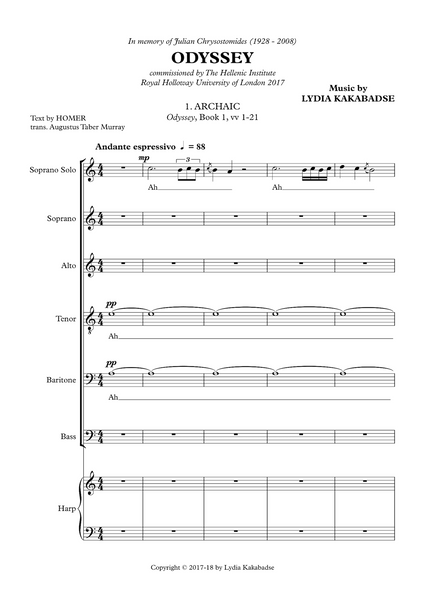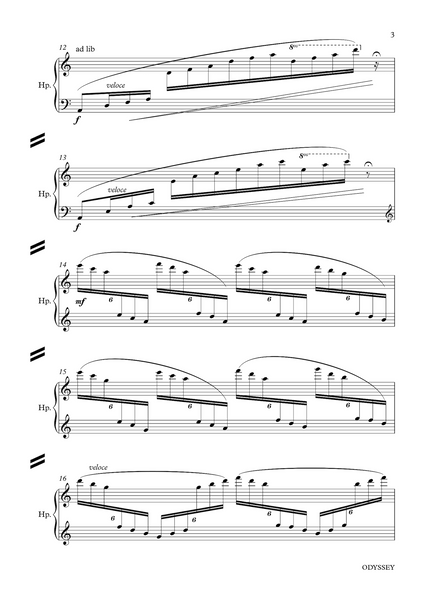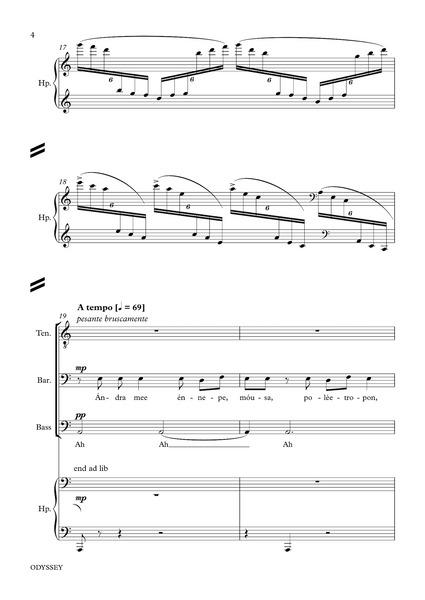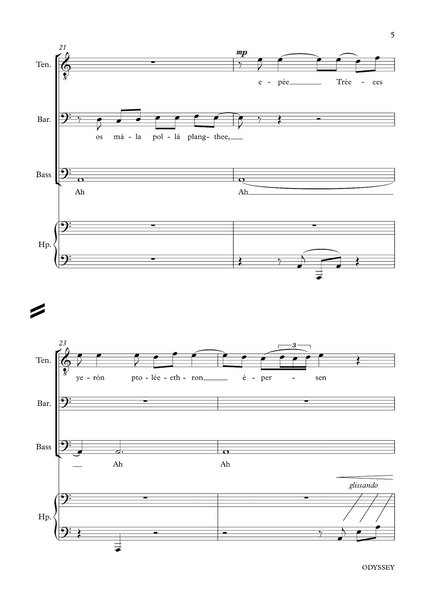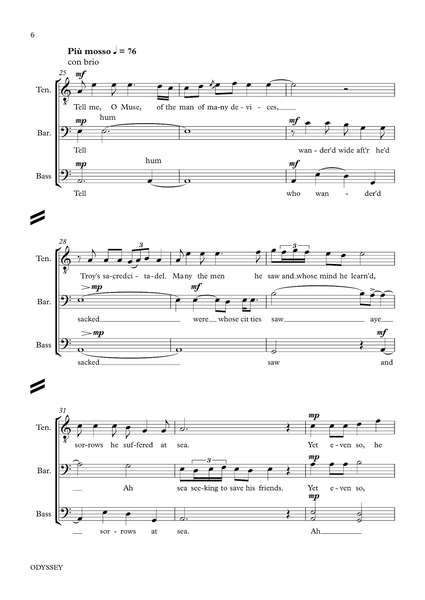Lydia Kakabadse: Odyssey – for mixed choir (SATBB) and harp (NXP160)
This is a sheet music edition of Odyssey by the composer Lydia Kakabadse.
Sheet music for mixed choir (SATBB) and harp
Score: 98 pages
Harp: 14 pages
Duration: 36 minutes
Audio samples
Preface and programme notes
Scored for SATBB with harp accompaniment, Odyssey was commissioned by the Hellenic Institute at Royal Holloway University of London to celebrate its 25th anniversary. The seven movements symbolize a musical journey through centuries of Greek history, culture and literature. The lyrics are taken from a selection of Greek poetry, representing successive eras from Homer (800 BC) to Modern Hellenism. Odyssey was premiered by The Choir of Royal Holloway at the College Chapel in October 2018 under the directorship of Rupert Gough.
1st movement: Archaic
Archaic music, already a sophisticated art at the time of Homer, was primarily monophonic, i.e. single melodic line without harmony. Important accompanying instruments were the kithara (a type of lyre) and the aulos (a double reed instrument). The aulos – organologically an oboe – consisted of two pipes (not connected); whilst one played the melody, the other functioned as a drone or other moving part.
The movement begins with a pianissimo drone (tenor, baritone and bass voices), over which the solo soprano delivers an introductory salutation, followed by a short bravura passage on the harp. The opening lines of Odyssey, Book 1, sung in Ancient Greek by male voices over a drone bass, lead to the main theme delivered by the tenors, who tell of the sufferings and hardships of Odysseus.
This theme is developed by the female voices, who depict his longing for his wife and home. The misfortunes, which befall Odysseus in Book VI, are portrayed by the solo tenor accompanied by the harp, following which a melodic phrase introduced by the harp, develops into a syncopated rhythmic passage between the male and female voices.
2nd movement: Classical
During the Classical period, a highly dramatic and emotional form of musical performance, known as the dithyramb, became popular and Pindar’s First Olympic Ode is represented in dithyramb-like style. Beginning in dramatic fashion with a rhythmic harp strum played con fuoco (with fire), the voices enter with fervid energy in octave echo-like effects. In contrast, Aeschylus’ Prometheus Bound portrays the pain, suffering and misery of Prometheus, chained to a crag at the edge of the world.
The special tremolo effect on the harp, together with the use of arpeggios in contrary motion, represent the rush of a winged chariot carrying the daughters of Oceanus to him. The final section relates to Sophocles’ Antigone and is scored for female voices with harp. It depicts the argument between Antigone (sopranos) and her sister Ismene (altos) over their brother’s burial, outlawed on penalty of death, which Antigone defies in order to honour him and obey the unwritten law. Despite clear discord between the sisters and the use of syncopation between the voices and harp, a feeling of tenderness pervades. The harp’s remarkable versatility is displayed throughout the movement.
3rd movement: Hellenistic
There is a direct correlation between Cavafy’s citizenship of Alexandria – a city which had been the great cultural centre of the Hellenistic era – and his persistent choice of Hellenistic themes as settings for his poems. Cavafy viewed this era as being more liberal, immoral and tolerant, consequently allowing him greater freedom of characterisation.
The underlying sense of irony, which runs throughout Waiting for the barbarians, very much characterizes the music. This pseudo-historical poem, which appears to be in dialogue form, is in fact a succession of revelations depicting civic hypocrisy. No matter what questions are asked about the attire and behaviour of the statesmen, the answer is the same – Because the barbarians are coming today. Whilst the first question is rendered in spoken form, the others are sung in an impassive manner without harp accompaniment.
In contrast, the answers are depicted in a rhythmic staccato style performed triumphantly by the upper voices and harp.
4th movement: Roman
Set to the text of Kyrie eleison, Christe eleison (Lord have mercy, Christ have mercy), this movement incorporates a number of features which epitomise the Greek Orthodox liturgy – chanting, drone bass, antiphons & responses, open triads and responsorial singing (solo chanting alternating with the choir). The use of parallel octaves and open 5th passages give rise to a stark chordal structure and short rhythmic sections are juxtaposed against smooth flowing passages. The harp is silent throughout.
5th movement: Byzantine
This movement is made up of two hymns, which I have arranged for mixed choir a cappella. Both hymns are sung in Greek. The anonymous Hymn to the Defender Mother of God (Akathistos Hymn) is a famous and well-loved hymn of the Byzantine Church, believed to have been written in the 6th century. The Kontakion on the Nativity of Christ was composed by St Romanos The Melodist, one of the greatest hymnographers of the Byzantine period. A kontakion is a form of thematic hymn and was significant in early Byzantine liturgical music.
6th movement: Post-Byzantine
The romance between Aretousa and Erotocritos, taken from 17th century Vitzentzos Kornaros’ Erotocritos, opens here with the solo soprano and female voices (collectively representing Aretousa) singing teneramente con dolore (tenderly with grief). Aretousa’s longing and desire for Erotocritos is reproduced by the use of the minor key, falling augmented 2nds, repetition of the same note and sequence of notes.
The mood changes when Erotocritos (represented collectively by the solo tenor and male voices) responds, admitting that he should never have aspired to win over Aretousa, a high-born Princess. In the final part, as depicted in a duet love song and then in full choir arrangement, the lovers find fulfilment in visions and dreams.
7th movement: Modern
The final movement is made up of two sections:The National Anthem of Greece (composed by Nikolaos Mantzaros) and Ithaka. The National Anthem, which I have arranged for mixed choir, is first sung by the choir a cappella in Greek and then repeated in English with the addition of soprano and alto soloists and harp. Ithaka, written by the distinguished twentieth century Greek poet, Constantine Cavafy, represents the destination of a person’s journey through life and suggests that it is the enjoyment of the journey, rather than the destination, which is important. Octave echo-like effects rising from basses to sopranos, reminiscent of the opening of the 2nd movement, herald the introduction to Ithaka.
The overall joyful mood is twice interrupted by the solemn delivery – quasi recitativo – of the solo alto issuing salutary warnings. Bringing together rhythmic and thematic material from earlier movements, Ithaka ends with great fervour, in triumphant and dramatic style.







